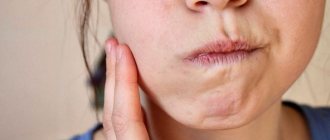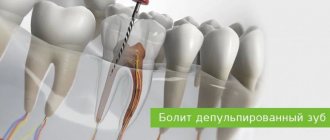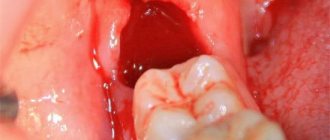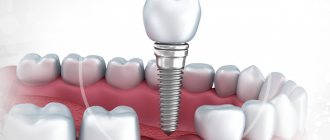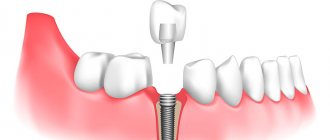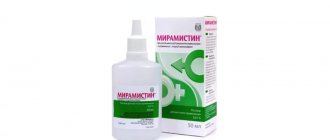Application in dentistry of furatsilin:
- Restoration of gums after installation of implants and dentures;
- Therapeutic therapy for wounds, ulcers, inflammation;
- Treatment of throat diseases that may spread to the oral cavity;
- Treatment of fistula in the gum;
- Rinse for gum disease;
- Application for swelling, dissolution of seals after injection;
- Treatment of plaque in the corners of the mouth after candidiasis.
Application of furatsilin
Indications for the use of furatsilin in dentistry are many diseases. The main ones are the following:
- Stomatitis - furatsilin solution is used as a local antiseptic and antimicrobial drug that has an effect on pustular formations;
- Gingivitis is an inflammatory process of the gums located in close proximity to the teeth. Rinsing reduces the severity of pain and prevents the spread of the process;
- Periodontitis is a complicated form of gingivitis, accompanied by bleeding from the gums and extensive inflammation. Rinsing prevents the spread of microorganisms and helps disinfect areas of inflammation;
- Toothache - rinsing teeth with furatsilin helps reduce the intensity of pain and also has an antiseptic effect;
- Tooth extraction - furatsilin solution prevents the development of secondary infections and promotes rapid healing of the gums.
The main advantage of using furatsilin in dentistry is its effect on those microorganisms that are resistant to antibiotics. However, the maximum effect is achieved only with the combined use of the rinsing solution and other medications prescribed by the dentist.
Pills
Furacilin tablets are used for self-preparation of solutions. Perfectly relieves symptoms of sore throat and nasal congestion. Tablets are convenient for storage. At any time, the patient has the opportunity to prepare a rinse solution for himself, which is very convenient. This can be done at work, at a party or on the road.
To prepare, grind the tablet to a powder and dissolve it in hot water. Use warm to rinse the nose, mouth and throat. Do not rinse with hot water to avoid damaging the mucous membrane.
Furacilin as a remedy for toothache
The antiseptic solution is not an analgesic in its direct action, but in some cases it can relieve toothache or reduce its intensity. The extent to which the fluid affects pain will depend on the severity of the pain and its cause. When such a situation occurs, the following actions must be taken:
- Prepare a solution of furatsilin by dissolving tablets, or use a ready-made form from a pharmacy;
- Bring liquid to room or warm temperature;
- Rinse the mouth with a primary focus on the diseased side of the tooth;
- Repeat the procedure several times (no more than 4-5 with an interval of fluid retention in the mouth of no more than a minute).
To achieve the best effect, it is recommended to take an analgesic and also make an appointment with a dentist. Rinsing the mouth with furatsilin for toothache can reduce its intensity by cleansing the oral cavity of pathogens, but this does not guarantee getting rid of the main cause of its occurrence.
Furacilin has been used in dentistry for several decades and remains one of the first antiseptics for various pathological processes. Its advantage lies in its effective action on numerous groups of microorganisms, availability of purchase and ease of use.
Category Hygiene, Medicines / preparations Published by Mister stomatolog
Ointment
Furacilin is also available in the form of an ointment. In this case, it effectively helps with burns, hypothermia, and also with purulent wounds. The composition of the ointment is slightly different from the solution. Contains additional components that have a calming and softening effect. The skin is smoothed, damaged tissues are regenerated, wounds and scars heal quickly.
In pharmacies you can purchase the product in tubes of 10 or 50 ml. Inside contains instructions for use. For minor surgical operations, ointment is prescribed to restore and remove the inflammatory process. It is often used to relieve inflammation of the ear canal.
How to rinse teeth correctly with furatsilin
Mouth rinsing involves several options, depending on the pathology, but for most of them standard techniques are used:
- Mouth rinse
- Rinsing with liquid retention in the mouth for up to 1 minute
- Intensive rinsing of a specific area of the mouth.
A distinctive point is rinsing the mouth with furatsilin after tooth extraction. In this case, the dentist gives clear recommendations that must be followed. The instructions are as follows:
- The first rinse after tooth extraction should be done no earlier than 24 hours later. Otherwise, the liquid may damage the blood clot in the socket, which will lead to complications;
- The solution should be at room temperature;
- The first rinses must be carried out carefully and without harsh actions; it is enough to take the liquid into the oral cavity and hold it on the side of the extracted tooth for no more than a minute, then spit it out;
- The procedure is repeated 3-4 times and no more than 5 times a day.
The course of mouth rinse after tooth extraction is up to 7 days. The active substance Nitrofural prevents the proliferation of pathogenic microorganisms in the area of the extracted tooth, and also has an analgesic and antiseptic effect. Taken together, a set of measures allows you to undergo tooth extraction painlessly and without complications.
Paste
Furacilin in the form of a paste is used for prevention in the summer. It protects the skin from exposure to high temperatures. Often used in chemical plants where toxic chemicals are produced.
The paste must be applied in a thin layer to exposed skin. Can be used on the face. The composition does not contain harmful substances. Has an anti-inflammatory effect. After application, a thin film is formed that protects the skin from exposure to harmful substances. Wash off with plain water and soap.
Solution
Furacilin solution can be purchased at the pharmacy in ready-made form. However, if you travel often and carry it with you, then it would be more advisable to buy tablets and make the solution yourself. They are easier to store without worrying about packaging.
The solution is used to treat throat problems: pharyngitis, tonsillitis and other inflammatory diseases. If you plan to treat only at home, then buy a ready-made solution. It will already be cooked in the correct proportions. You will be sure of its sterility, and the packaging will be sealed.
When preparing yourself, you must carefully follow the instructions. Because if the solution turns out to be too concentrated, you can damage the mucous membrane, which is already inflamed. If the concentration is insufficient, the drug may not have the desired effect.
By rinsing with furatsilin, negative microorganisms are eliminated from the mucous membrane. When preparing the solution yourself, do it for 1 procedure so that it is always fresh. The drug should be stored in a cool, dark place.
Diseases of teeth and gums
Treatment strategy for gingivitis
How is gum inflammation treated? The pathogenesis is based on the inflammatory process, which means that it is necessary to include medications with anti-inflammatory activity in treatment regimens. The etiology, or cause of the disease, may be associated with the activation of pathogenic microorganisms, and therefore it is advisable to use antimicrobial agents.
Of all the symptoms, pain is the most uncomfortable; To reduce discomfort, pastes or gels with adhesive and analgesic properties should be used. They not only relieve pain, but also protect the mucous membrane from the negative effects of food and drinks and accelerate regeneration.
Solutions, infusions and decoctions for rinsing
One of the main methods of treating gingivitis is rinsing. If you have gum inflammation, you can rinse your mouth with pharmaceutical or folk remedies - decoctions and infusions of medicinal herbs prepared at home.
Pharmacy medications for rinsing
Chlorophyllipt.
Plant-based pharmaceutical rinse. Chlorophyllipt has a pronounced antibacterial effect and is effective against a wide range of microorganisms. It is produced in the form of a concentrated green alcohol solution with a pine smell, which requires dilution. To cure inflammation of the gums near the tooth, add one or two tablespoons (or one or two caps) of chlorophyllipt to 100 ml of warm water. You should rinse your mouth with chlorophyllipt several times a day.
Chlorhexidine bigluconate.
A time-tested disinfectant that has a detrimental effect on many pathogenic microorganisms. Widely used in dental practice. Available in the form of a solution with a concentration of 0.05%, 0.1% and 0.2%. You can rinse your mouth with a 0.05% solution of chlorhexidine bigluconate without prior dilution. It is advisable to dilute more concentrated solutions with warm water in a ratio of 1:2 or 1:4.
Miramistin.
An antiseptic that is actively used to prevent and treat infections of the skin and mucous membranes. When treating gum inflammation, a 0.05% solution of miramistin is used, which does not require prior dilution. You should rinse your mouth or irrigate the inflamed area with an antimicrobial agent several times a day, at intervals of 2-3 hours.
Furacilin.
Furacilin solution is one of the most effective and popular antibacterial agents. It is still actively used in surgical practice; furatsilin is also used in the treatment of dental pathologies. Available in tablets. Before rinsing, you need to dilute 1 tablet of furatsilin in 100 ml of water.
Hydrogen peroxide
- a universal remedy with powerful antimicrobial potential, which is used both in surgery and at home. In dentistry, hydrogen peroxide is used for many diseases of the oral cavity. For gingivitis, it is recommended to rinse your mouth with a 3% peroxide solution. You can also apply cotton swabs soaked in an antibacterial agent to the inflamed mucosa.
Rotokan.
Those who prefer traditional herbal-based products can rinse their mouth with Rotokan solution. The natural preparation contains a combination of yarrow, calendula and chamomile extracts. Before use, it requires dilution: add about one teaspoon of Rotokan solution to a glass of warm water.
Traditional medicine
Substances of plant origin are included in many pharmaceutical rinses, but healing solutions can be prepared independently, at home.
To do this, you just need to purchase the necessary ingredients and mix them in the correct proportions. You should choose herbs that promote the reverse development of inflammation, reduce pain, suppress the activity of microbes and accelerate regenerative processes. For inflammation of the gums, the following folk remedies have a good effect:
- Calendula;
- Oak bark;
- Chamomile;
- Oregano;
- Yarrow;
- St. John's wort;
- Sage;
- And others.
To brew a calendula infusion, just take one tablespoon of the plant’s flowers and pour 200 ml of boiling water over it.
Let it brew for 1-2 hours, then use the infusion for rinsing without additional dilution. To prepare chamomile infusion you will need 2 tbsp. l. plant flowers. Next, everything is standard - pour 200 ml of boiling water, let it brew and use it for rinsing or mouth baths. Preparing a healing remedy from yarrow is a little more difficult. Boil two tablespoons of plant flowers for 15 minutes. Then the broth is filtered and allowed to cool to a temperature of 38-40 degrees. You need to rinse your mouth with yarrow decoction several times a day. A decoction of oak bark is prepared in the same way, but the heat treatment time in this situation increases to 30 minutes. It’s easier to make a healing infusion of sage at home - just pour 200 ml of boiling water over a tablespoon of inflorescences. The solution is infused for about an hour, after which it can be used for mouth baths or rinsing. You can also use other medicinal herbs for rinsing: plantain, mint, agave, linden, St. John's wort or oregano. All mouthwashes, both pharmaceutical and homemade from medicinal herbs, must be used regularly. Rinse your mouth after each meal, especially carefully on the affected side. This will help clear the mucous membrane of food particles, which can be irritating, increase the inflammatory process and inhibit the regeneration of the epithelium. After rinsing, you can additionally treat the inflamed area with ointment or gel; Pharmacy pastes for topical use are discussed in the next section of the publication.
Local remedies: pastes, ointments and gels
Rinsing allows you to quickly and efficiently clean the oral cavity, but the effect of medicinal substances from solutions is limited in time.
In order for the healing process to proceed continuously, after rinsing it is necessary to treat the inflamed mucous membrane with a special adhesive film-forming agent - ointment, paste or gel. Dental pastes create a thin but durable film on the surface of the mucosa, which serves as a barrier layer. This barrier protects the damaged area from the unwanted effects of external factors - chemical components of food and drinks, tobacco smoke, food particles. Aggressive environmental factors irritate the mucous membrane and can provoke repeated damage to the painful area, which not only increases pain, but also inhibits the processes of regeneration and self-healing. With gingivitis, it is extremely important to prevent the negative impact of external factors on epithelial tissue. For this purpose, it is necessary to use dental ointments, balms or gels. In addition to the protective function, many pastes have anti-inflammatory, antibacterial, analgesic and wound-healing effects. They reduce swelling and redness, relieve discomfort (reduce itching, pain and burning), and accelerate regenerative processes.
Metrogil Denta
. Dental gel with a powerful antibacterial effect. Metrogyl Denta contains two substances with antimicrobial activity - metronidazole and chlorhexidine. Apply to the mucous membrane 2 times a day with a cotton swab or finger, after thoroughly cleansing the oral cavity. After applying the product, it is advisable not to drink or eat for at least half an hour.
Solcoseryl Denta.
Dental paste with a wound-healing effect, which is actively used to treat gum and periodontal diseases. Apply with a finger or a cotton swab to previously cleaned and dried mucous membranes. There is no need to rub in Solcoseryl Dent; just spread it over the surface in an even layer. You need to treat the affected area 2 or 3 times a day. Solcoseryl Denta paste does not have antimicrobial activity.
Holisal Dental.
Dental gel with anti-inflammatory and analgesic properties. Contains natural ingredients that reduce pain and relieve inflammation. Does not have antimicrobial activity. Holisal Dental should be applied 2-3 times a day. You can use this product both before and after meals to create a protective layer on the damaged area and reduce discomfort during meals.
Asepta.
Dental gel developed specifically for the treatment of inflammatory diseases of the gums and periodontium. Contains propolis extract, has anti-inflammatory and antimicrobial effects. Reduces discomfort (itching, burning, pain). Accelerates epithelial regeneration. Asepta is applied to the cleansed mucous membrane of the inflamed area 2-3 times a day. It is advisable not to drink or eat for half an hour after applying Asepta gel.
Medicinal toothpastes
Even if you regularly brush your teeth with expensive, high-quality toothpaste, gingivitis requires a special approach. Whitening compounds are not suitable - it is necessary to brush your teeth with medicinal pastes, which are developed taking into account the requirements for the treatment of this disease. Lakalut Active
has a good effect .
"President Active"
- another toothpaste that helps relieve inflammatory processes and suppresses the activity of pathogenic microorganisms. It is recommended to brush your teeth with this paste for 2-3 weeks, until the integrity of the epithelium is completely restored. As an alternative to the pastes mentioned above, you can use Parodontax, which contains plant extracts with anti-inflammatory effects.
Gingivitis and antibiotics
Do I need to take antibiotics for gum disease?
On the one hand, the cause of gingivitis may be the activation of pathogenic or opportunistic flora, and therefore the decision in favor of antibiotics seems justified. In fact, topical antiseptics, which were discussed in previous sections of the publication, are sufficient to suppress pathogens. Systemic antibiotics are rarely used for gingivitis, and only as prescribed by a dentist. You cannot take antibacterial drugs on your own. This can lead to disruption of the normal biocenosis of the oral cavity and the entire digestive system. Dysbacteriosis negatively affects regenerative processes and promotes the activation of pathogenic organisms, in particular fungi of the genus Candida, which can lead to the development of candidal stomatitis. Make an appointment
Is furatsilin allowed during pregnancy and breastfeeding?
During pregnancy, furatsilin is approved for external use. The solution is recommended to be used for washing for preventive purposes and for the treatment of bacterial infections. Thrush often accompanies women during this period; furatsilin can reduce its manifestation and relieve the inflammatory process.
When breastfeeding, furatsilin is used externally with caution.
This is due to the fact that after using it, the milk may have a bitter taste and the baby will refuse the breast. Therefore, use during this period should be strictly monitored by a doctor to avoid negative consequences. This article is for informational purposes only, please consult your doctor for details! Ask your doctor about contraindications and side effects.
